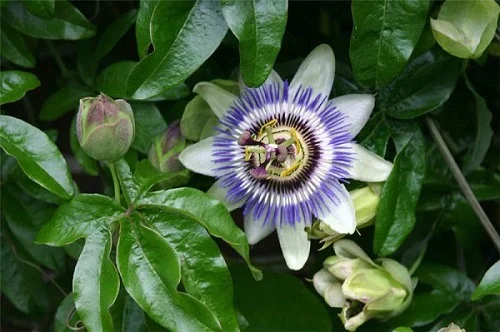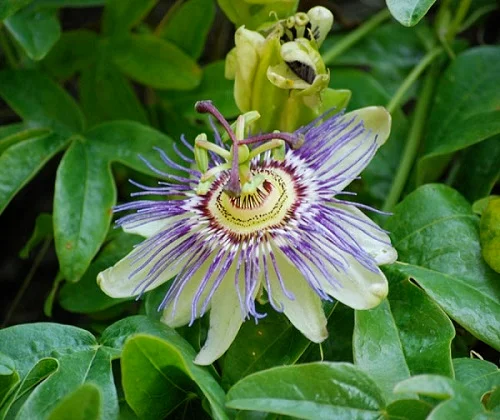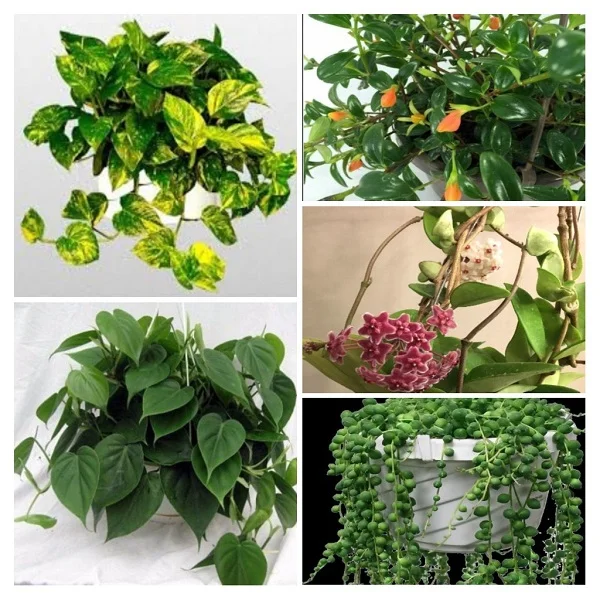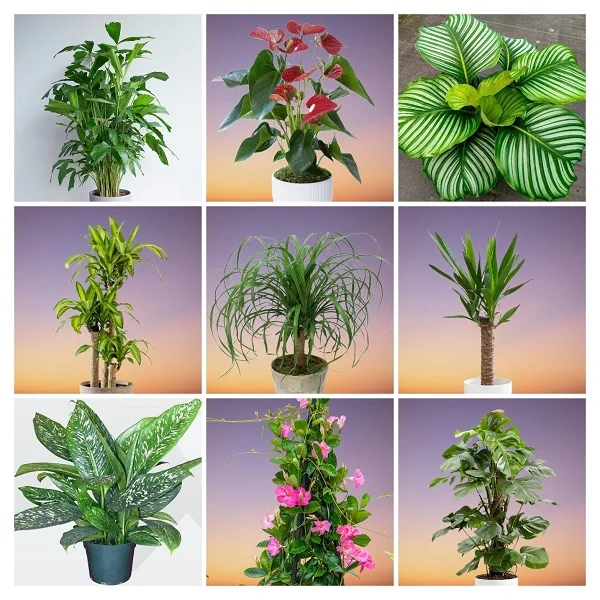How to Grow and Care for Bluecrown Passionflower (Passiflora caerulea) Indoors
Some links in this post may be affiliate links
Bluecrown Passionflower (Passiflora caerulea) grows best in bright light with some direct sunlight, average warmth, humid conditions and consistently moist, rich, free-draining, all purpose soil coupled with monthly feeding in the growing season.
Passiflora caerulea also called Blue Passionflower, Southern Beauty, Wild Apricot, Jesus Flower or Passion Flower is among the popular flowering plants with fragrant blue-white flowers and a rampant climber ideal for indoors.
If left unpruned, Bluecrown Passionflower can become unruly. The stems bear deeply-lobed leaves, tendrils and short-lived flowers all through the growing season.
Bluecrown Passionflower bears fragrant blue-white flowers with a prominent fringe of filaments in bands of blue, white and brown. The fruits are orange, small, oval-shaped, edible but bland.
Blue Passionflower is ideal for a trellis or a hanging basket where it can display its beautiful flowers and leaves. It is one of the best flowering plants for hanging baskets.

Botanical name: Passiflora caerulea
Family: Passifloraceae
Common names: Bluecrown Passionflower, Blue Passionflower, Southern Beauty, Wild Apricot, Jesus Flower, Passion Flower
Origin
Passiflora caerulea is native to the rain forests of Brazil and Argentina where it grows by clinging on tree trunks by use of the tendrils.
Toxicity
Bluecrown Passionflower plants are toxic to humans and pets. If ingested they can cause a vomiting, diarrhea and abdominal pains. Keep these plants from the reach of children and pets.
Where to Buy
Are you looking to acquire these plants to your collection? Blue Passionflower Plants are readily available on Etsy (Link to Etsy).
Passiflora caerulea Care Indoors
Bluecrown Passionflower (Passiflora caerulea) requires bright light with 4-6 hours of direct sunlight, average warmth of 18-270C, humidity of 60-70% and consistently moist, fertile, free-draining, all purpose soil coupled with monthly feeding during the growing season.
Passiflora caerulea requires regular pruning to keep it neat as well as encourage a bushy growth. Repotting is necessary only when the plant is extremely pot-bound as it blooms more when pot-bound. Keep reading for more details on these growing conditions and how to achieve them.

Watering
Water Bluecrown Passionflower thoroughly and keep the soil moist at all times. Do not allow the soil to dry out completely.
Decrease watering in the cold season as growth is minimal at this time but do not allow the soil to dry out completely.
Ensure that the pot has a draiange hole to prevent the soil from getting soggy as it can result in root-rot and the death of the plant.
Light Requirements
Bluecrown Passionflower grows best in bright light with 4-6 hours of morning or afternoon sunlight to promote flowering. If light is inadequate, it may not bloom
You may grow Passiflora caerulea under grow lights where natural light is not sufficient. Check out these full spectrum grow lights on Amazon.
Regularly turn the pot to ensure that the plant receives light on all sides for uniform growth and prevent legginess.
Temperature and Humidity
Average warmth of 18-270C is ideal for Bluecrown Passionflower. Cool nights and warm days with a minimum of 150C are necessary to trigger flower buds. Protect or keep it from cold and hot drafts to prevent sudden changes in temperature as they can cause leaf drop and reduced growth.
Bluecrown Passionflower prefers high humidity of 60-70% to thrive. Set the pot on a wet pebble tray or use a cool mist humidifier to raise humidity. Read more on how to increase humidity for houseplants.
Once in a while clean the leaves by damp-wiping with a soft cloth to get rid of dust as well as discourage pest and disease infestation. Make sure that there is good ventilation to minimize fungal diseases.
Fertilizer
Feed Bluecrown Passionflower with a balanced, water-soluble fertilizer every 4 weeks during the growing season. Do not feed in the cold season as growth is minimal at this time.
To promote flowering in Blue Passionflower apply a phosphorous-rich, water-soluble fertilizer weekly during bud formation.
Potting Soil
The best soil for Bluecrown Passionflower should be rich in organic matter and free-draining to prevent it from getting soggy while providing the required nutrients. Most all purpose potting mixes are ideal for the plant.
Repotting
Repot Bluecrown Passionflower during the growing season only when the plant is extremely pot-bound as it blooms more when pot-bound. Repot into a pot 1 size larger and one that has a drainage hole to prevent the soil from getting soggy as it can lead to root-rot. Take a look at these pots with drainage holes on Amazon.
Do not repot a plant that is in flower as it can shorten the flowering period due to repotting shock. The large plants can be top-dressed by replacing the top 3-4 inches of soil with fresh soil.
Pruning
Pruning Bluecrown Passionflower is easy. Remove dead flowers to maintain the plant neat as well as discourage pests and diseases. Pinch off the growing tips to encourage compact growth and prevent the plant from getting unruly. After flowering, cutback the stems to rejuvenate growth.
Propagation
Bluecrown Passionflower (Passiflora caerulea) propagation can be done at the beginning of the growing season from stem-tip cuttings or from seeds.
How to propagate Bluecrown Passionflower from stem-tip cuttings
Take a 4-6 inches stem-tip cutting from a healthy Bluecrown Passionflower plant and ensure it has at least 2-3 leaf nodes.
Insert the cutting in moist free-draining soil and place the set up in a warm, well-lit spot away from direct sunlight.
Maintain the soil moist through out until the new Blue Passionflower plants are well established after which routine care can begin.
How to propagate Bluecrown Passionflower from seeds
Sow the Bluecrown Passionflower seeds about 1/2 inch deep in moist free-draining soil.
Cover the set up with a plastic sheet to create a greenhouse effect and place the set up in a warm, well-lit place.
Maintain the soil moist through out until the Blue Passionflower plants are well established.
Gradually remove the plastic cover to acclimatize the new Bluecrown Passionflower plants to ordinary growing conditions.

Passiflora caerulea Problems
Bluecrown Passionflower (Passiflora caerulea) problems include leaf drop, yellowing, wilting, flowerbud drop, pests and diseases. Keep reading for more on these problems and how to fix them.
Pests
Common pests in Bluecrown Passionflower are spider mites, aphids and scales. Isolate the affected plant to prevent spread to other plants and treat it for the pests. Learn how to identify and control houseplants pests.
Diseases
Bluecrown Passionflower is prone to powdery mildew which is characterized by grey mould on the leaves and is prevalent in warm and humid conditions. Therefore, do not mist the plant and improve air circulation to discourage the disease.
Yellowing and dropping leaves
There are two possible causes of yellowing and dropping leaves in Bluecrown Passionflower. One possible cause is too little light. Position the plant in a brighter spot where is will receive bright light with 4-6 hours of direct sunlight or instal a grow light where natural light is inadequate. Check out this guide on understanding light for houseplants.
The second possible cause of yellowing leaves and leaf drop in Bluecrown Passionflower is underwatering. Maintain the soil consistently moist and never allow the soil to dry out completely.
Dropping flower buds
The are two possible causes of flower bud drop in Bluecrown Passionflower. One possible cause is underwatering. Water the plant thoroughly during the growing season and maintain the soil consistently moist. Reduce watering in the cold season but never allow the soil to dry out completely. Learn more on how to water indoor plants the right way.
The second possible cause of flower bud drop in Blue Passionflower is underfeeding. Feed the plant every 4 weeks during the growing season with a balanced, water-soluble fertilizer. To boost flowering, feed it with a phosphorous-rich, water-soluble fertilizer weekly during bud formation. Learn how to feed houseplants.
Yellowing and wilting leaves
Yellowing and wilting leaves in Bluecrown Passionflower are due to underwatering. Maintain the soil consistently moist during the growing season. Reduce watering in the cold season but never allow the soil to dry out completely.
You liked it? Share on social media.
Related Content
Amazon Associates Disclosure
Homeplantsguide.com is a participant in the Amazon Services LLC Associates Program, an affiliate advertising program designed to provide a means for sites to earn advertising fees by advertising and linking to amazon.com.





